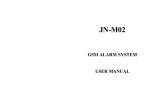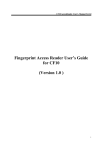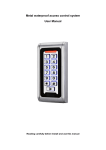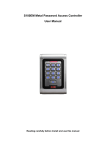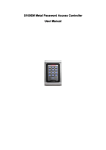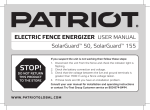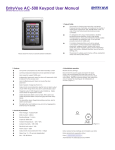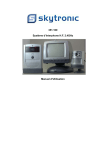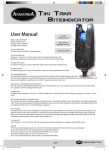Download SolarGuard® - solar
Transcript
SolarGuard® Driveway Receiver User Manual 1. Purpose & Application 1.1. The driveway receiver (buzzer box) is designed to be used in conjunction with a pair of SolarGuard® which provides a warning of vehicles or pedestrians entering a designated area. 1.2. The driveway receiver (buzzer box) can receive signals from up to six sets of SolarGuard®. 1.3. The driveway receiver (buzzer box) has a relay contact to permit connection of an extension buzzer or flashing light to make the alert more noticeable. The relay contact turns on and off a 9 volt supply. 1.4. If an alert in several locations is required then an additional driveway receiver may be used with the same set of SolarGuard®. 1.5. If desired to receive alerts while moving about a site or at a remote location then the SolarGuard® Auto-Dialler receiver may be used with, or instead of the driveway receiver (buzzer box) to call any mobile phone or landline phone and play a short pre-recorded message. 1.6. The driveway receiver (buzzer box) is not designed to receive signals from other manufacturer’s equipment. 2. Setting up the receiver 2.1. The driveway receiver (buzzer box) must be positioned so that is has a clear radio path from the SolarGuard®. The radio beam will travel in an essentially straight line. It will go through trees, windows, non-metallic building walls etc, but the range will be reduced. The beam will not pass through metal eg corrugated iron walls of a barn (but through the barns window line of site etc). The beam will also be blocked by ground contours eg if there is a hill between the receiver and transmitter. If obstructions are a problem then a wireless repeater may enable you to get around this problem. Consult your SolarGuard® distributor. In open space with no obstructions the SolarGuard® beams can be up to 1km (3200 feet) from the driveway receiver (buzzer box). 2.2. The power pack supplied with the driveway receiver (buzzer box) plugs in to the socket on the back of the receiver. 2.2. The receiver should give three short beeps (“dididi“) when turned on, and the power LED will glow to show the correct connection. 3. Programming the receiver 3.1. Hold in the set button, on the rear of the receiver, for approximately 3 seconds until a long beep is heard, then release the button. Generate a signal from the SolarGuard® beams. - With the SolarGuard® turned on and aligned, break and generate an alarm. 3.2. The receiver will give two short beeps (didi) when it has successfully learnt the SolarGuard® code and the LED for that zone will light temporally. 3.3. After the receiver has learnt one code from a set of SolarGuard® beams it is necessary to repeat steps 3.1 and 3.2 to learn the next code if additional sets of SolarGuard® are being installed to the receiver. 3.4. If there are already 6 codes in the receiver it will give a succession of 4 short beeps (didididi,didididi,didididi). The memory must be erased as in section 3.5. 3.5. The driveway alert receiver can only receive signals from up to 6 sets of SolarGuard®. If you wish to erase a set of SolarGuard® from the receiver, you must erase the memory and programme in each SolarGuard®. Press the set key and hold it in for 10 seconds. After 3 seconds a long beep will be herd. After 10 seconds four short beeps will be herd (didididi). The set button may now be released. NOTE erasing the memory will clear all programmed sets of SolarGuard®. If you wish to retain some of them, they will have to be reprogrammed. 3.6. The driveway receiver will retain the learnt sets of SolarGuard® in its memory even if the power supply is disconnected. 4. Operating of the receiver 4.1. When the driveway alert receives a signal it will sound the internal buzzer for 3 seconds and the LED for the appropriate zone will light until the set button is pressed or another zone is triggered. 4.2. The normally open (NO) relay will close for 3 seconds, turning on any buzzer or light connected to it. 4.3. If the zone light is lit pressing the set button will briefly turn of the zone light. 4.4. If no zone light is lit and the set button is pressed briefly the Output Enable light turn off. The buzzer will no longer sound when a zone is triggered. The relay will still operate and the zone light will still come on. 4.5. To enable the buzzer press the set button briefly. The Output Enable light will come on. 5. Connection of extension bells 5.1. The external buzzer or flashing light is connected to the screw terminals on the front of the receiver. The driveway receiver provides a Normally Open (NO) contact which closes on activation. Driveway Receiver Relay Contact Internal Power Supply Driveway alert receiver can connect an additional buzzer or flashing light Typical connection to an external buzzer or flashing light. The driveway receiver provides 9 volt DC, to the relay contacts to power an external bell buzzer or light. Maximum current is 200mA. Polarity of the terminals is shown in the diagram below: ZONE 1 ZONE 2 ZONE 5 ZONE 6 ZONE 3 ZONE 4 Relay Output OUTPUT ENABLE Ground terminal - Positive terminal +



